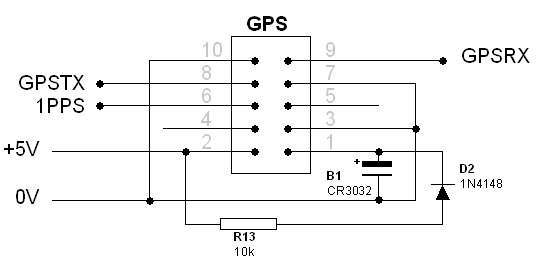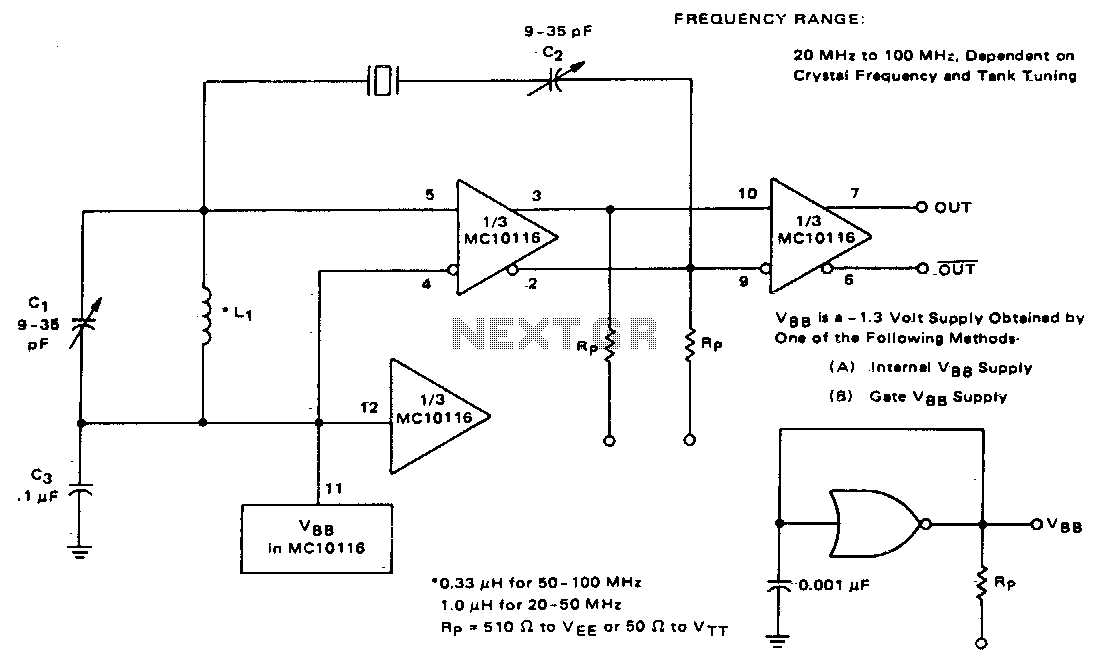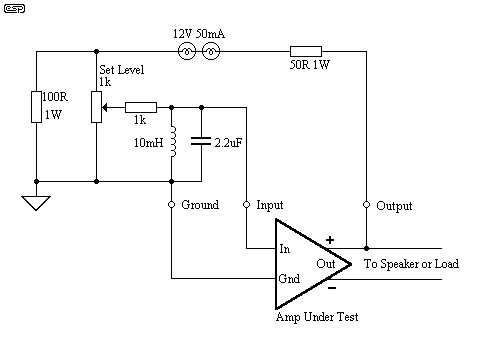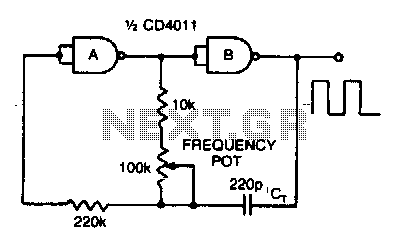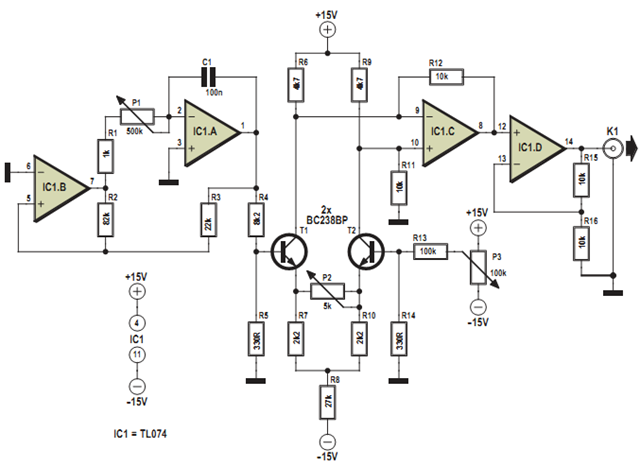
µP-Controlled Oscillator Delivers Rock-Bottom Distortion

Function generators are essential in the design, testing, and operation of encoders, modulators, demodulators, and measurement instruments. This document presents an economical method to construct a bus-controlled sinewave oscillator that exhibits exceptionally low distortion. The circuit produces a sinusoidal output with typical second and third harmonics attenuated by -76.1 dB and -74.2 dB, respectively, across an output frequency range of 10 Hz to 10 kHz. This performance provides a significant improvement of over 40 dB compared to standard diode-shaped sinewave generators, which typically achieve second- and third-order harmonic attenuation of -35 dB and -25.5 dB, respectively. The circuit is divided into four sections. The first section includes the oscillator, which consists of an integrated circuit dual-filter building block (U1), a second-order clocked filter that sets the oscillator's frequency, and a comparator (U2A). The bandpass filter allows signals near its center frequency to pass, determining the oscillator's frequency, as described in Equation 1. The second section features a tracking notch filter that is set to follow the oscillator's third harmonic, which possesses the highest amplitude. This tracking filter is synchronously clocked with the frequency-setting filter of the oscillator to ensure precise tracking. The third section contains a buffer amplifier (U3A) with a gain of -1, along with a 13.3 kHz low-pass filter that minimizes high-frequency components generated by the clocking steps in the output waveform. The fourth section is a bus-controlled clock generator, primarily composed of a serial-port programmable oscillator IC (U4), which can be either the LTC6903 for SPI or the LTC6904 for the I2C interface. The only external components required are some pull-up resistors, a decoupling capacitor, and a resistor in series with the output. Additionally, the circuit can be easily modified to generate quadrature sine/cosine waveform outputs by adding a second output operational amplifier and connecting its input to the bandpass output of U1 (BPB at pin 11).
The described circuit provides a robust solution for generating low-distortion sinewave outputs suitable for a variety of applications in electronic design and testing. The use of a dual-filter building block allows for precise frequency control, while the tracking notch filter ensures that unwanted harmonics do not affect the output quality. The buffer amplifier serves to isolate the oscillator from subsequent stages, maintaining signal integrity. The integration of a bus-controlled clock generator allows for flexible interfacing with microcontrollers or other digital systems, facilitating easy integration into larger electronic systems. The option to modify the circuit for quadrature outputs enhances its versatility, making it suitable for applications such as phase modulation and signal processing. Overall, this bus-controlled sinewave oscillator design exemplifies a cost-effective approach to generating high-quality sinusoidal signals with minimal distortion.Function generators often play a critical role in the design, testing, and operation of encoders, modulators, demodulators, and measurement instruments. Here`s an inexpensive way to build a bus-controlled sinewave oscillator that has downright low distortion.
The circuit generates a sinusoidal output with typical second and third harmonics down fr om the fundamental by -76. 1 and -74. 2 dB, respectively, across its full output range of 10 Hz to 10 kHz. That performance represents better than a 40-dB improvement over common diode-shaped sinewave generators, which employ a diode-shaping technique to transform a square wave into a sinewave. Typically, their second-and third-order harmonics are down from the fundamental by -35 and -25. 5 dB, respectively. The circuit consists of four sections ( see the figure ). At the heart of the design, the first one is the oscillator comprising an IC dual-filter building block (U1), a second-order clocked filter (whose bandpass-filter section sets the oscillator`s frequency), and a comparator (U2A).
The bandpass filter determines the oscillator`s frequency by allowing signals only around its center frequency to pass. Equation 1 shows the oscillator frequency, and Equation 2 the filter The second circuit section is the tracking notch filter, which is set to and tracks the oscillator`s third harmonic, which is the higher-amplitude harmonic.
The tracking filter is synchronously clocked with the oscillator`s frequency-setting filter to provide lock-step oscillator-tracking filter-response characteristics. The third section has a buffer amplifier (U3A) with a gain of -1. This section includes a 13. 3-kHz low-pass filter to reduce the high-frequency component generated by the clocking steps in the output waveform.
The fourth section is a bus-controlled clock generator that mainly comprises an IC serial-port programmable oscillator (U4), which can be either the LTC6903 for the serial peripheral interface (SPI) or the LTC6904 for the Inter-IC (I2C) interface. Some pull-up resistors, a decoupling capacitor, and a resistor in series with the output are the only external components required.
Plus, the circuit can be modified easily to produce a quadrature, sine/cosine-waveform output. Just add a second output op amp and take its input from the bandpass output of U1 (BPB at pin 11). 🔗 External reference
The described circuit provides a robust solution for generating low-distortion sinewave outputs suitable for a variety of applications in electronic design and testing. The use of a dual-filter building block allows for precise frequency control, while the tracking notch filter ensures that unwanted harmonics do not affect the output quality. The buffer amplifier serves to isolate the oscillator from subsequent stages, maintaining signal integrity. The integration of a bus-controlled clock generator allows for flexible interfacing with microcontrollers or other digital systems, facilitating easy integration into larger electronic systems. The option to modify the circuit for quadrature outputs enhances its versatility, making it suitable for applications such as phase modulation and signal processing. Overall, this bus-controlled sinewave oscillator design exemplifies a cost-effective approach to generating high-quality sinusoidal signals with minimal distortion.Function generators often play a critical role in the design, testing, and operation of encoders, modulators, demodulators, and measurement instruments. Here`s an inexpensive way to build a bus-controlled sinewave oscillator that has downright low distortion.
The circuit generates a sinusoidal output with typical second and third harmonics down fr om the fundamental by -76. 1 and -74. 2 dB, respectively, across its full output range of 10 Hz to 10 kHz. That performance represents better than a 40-dB improvement over common diode-shaped sinewave generators, which employ a diode-shaping technique to transform a square wave into a sinewave. Typically, their second-and third-order harmonics are down from the fundamental by -35 and -25. 5 dB, respectively. The circuit consists of four sections ( see the figure ). At the heart of the design, the first one is the oscillator comprising an IC dual-filter building block (U1), a second-order clocked filter (whose bandpass-filter section sets the oscillator`s frequency), and a comparator (U2A).
The bandpass filter determines the oscillator`s frequency by allowing signals only around its center frequency to pass. Equation 1 shows the oscillator frequency, and Equation 2 the filter The second circuit section is the tracking notch filter, which is set to and tracks the oscillator`s third harmonic, which is the higher-amplitude harmonic.
The tracking filter is synchronously clocked with the oscillator`s frequency-setting filter to provide lock-step oscillator-tracking filter-response characteristics. The third section has a buffer amplifier (U3A) with a gain of -1. This section includes a 13. 3-kHz low-pass filter to reduce the high-frequency component generated by the clocking steps in the output waveform.
The fourth section is a bus-controlled clock generator that mainly comprises an IC serial-port programmable oscillator (U4), which can be either the LTC6903 for the serial peripheral interface (SPI) or the LTC6904 for the Inter-IC (I2C) interface. Some pull-up resistors, a decoupling capacitor, and a resistor in series with the output are the only external components required.
Plus, the circuit can be modified easily to produce a quadrature, sine/cosine-waveform output. Just add a second output op amp and take its input from the bandpass output of U1 (BPB at pin 11). 🔗 External reference
